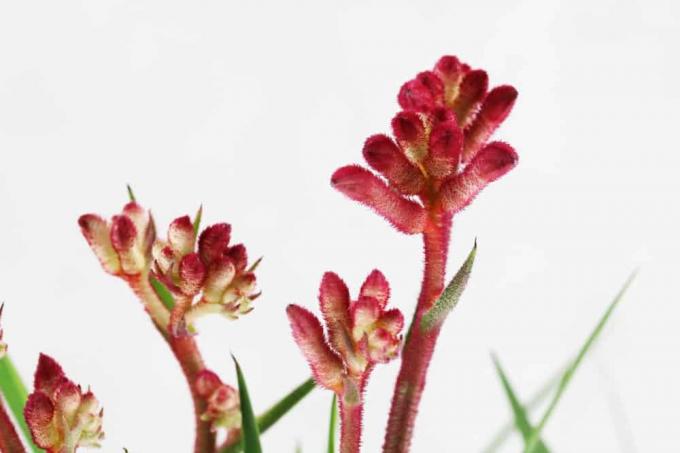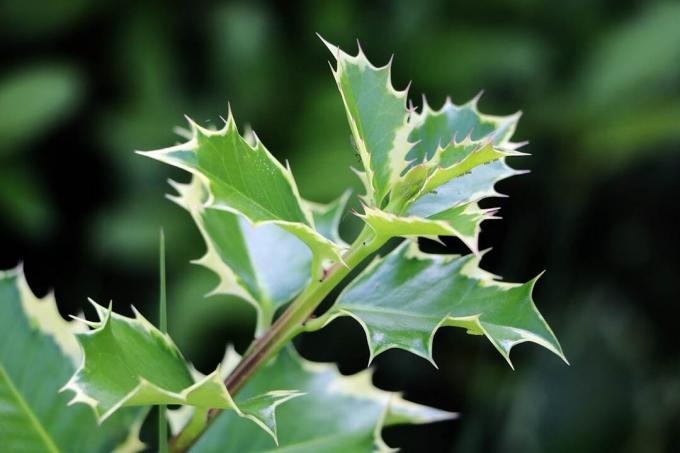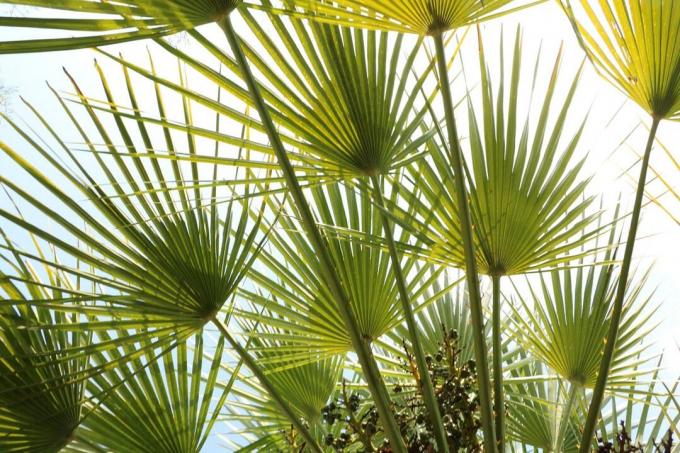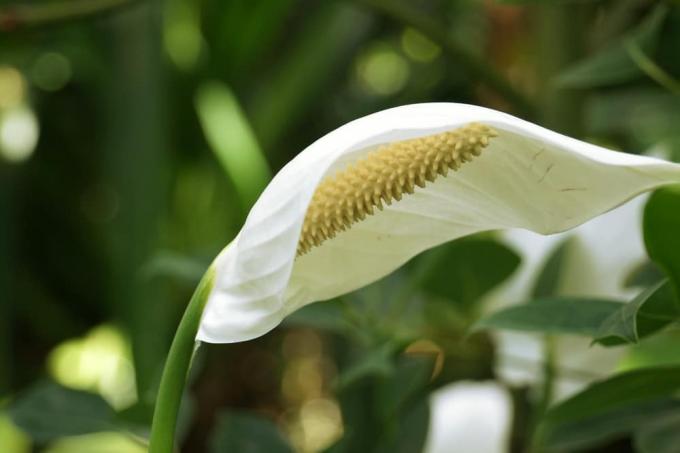

Table of contents
- Characteristics
- Location
- substrate
- Pour
- Fertilize
- Cut
- hibernate
- multiply
- rhizome division
- cuttings
- sowing
- repot
- Diseases
- pests
The kangaroo paw is an exotic plant that got its name from the unusual shape of the flower. Several tubular individual flowers crowd together in the inflorescences, so that they are reminiscent of the paw of Australia's national animal. Unlike the kangaroo, this plant does not prefer dry and hot conditions. In order for Kangaroo Paw to thrive in Central European regions, special care instructions must be observed.
Characteristics
- scientific genus name: Anigozanthos
- Genus contains ten species plus some subspecies and varieties
- Plants move into natural habitats during the dry season
- sprout again as perennial plants after the winter rain
- Inflorescences of some species are up to 150 centimeters high
- Flowers are hermaphrodite and have fused bracts that are woolly hairy
Location
The kangaroo paw is considered warmth-loving. A partially shaded windowsill facing west or east with bright light conditions is an ideal location for Anigozanthos species. Bright rooms with indirect light support flowering. This exotic plant blooms in spring. The sunny south window is also tolerated if the room is regularly ventilated and the care instructions are observed. Kangaroo Paw is a real houseplant, but during the summer months it likes a warm spot on the balcony and patio. In addition to optimal lighting conditions, a prerequisite is an airy location so that the heat does not accumulate.
A notice:
Protect the tropical plant from drafts and rain. The kangaroo paw does not particularly like such conditions.
substrate
The kangaroo plant prefers a substrate with a loose structure that ensures optimal water drainage and at the same time stores water. Clay granules and quartz sand are ideal for improving the coarseness of the soil. You can add coco hum to the soil to improve water storage capacity. Make sure that the substrate is lime-free. Over time, too much lime content will have a negative impact on the absorption of water and nutrients. A substrate with a pH of 6.0 is ideal. These substrates have proven to be well suited:
- azalea substrate
- Deciduous or peat soil
- orchid substrate
- Potting soil or peat substitute
Pour

The water requirement of the kangaroo plant is in the middle range. In the natural habitats, the soil is always moist. When cultivating in a pot, you should make sure that the substrate neither dries out completely nor gets waterlogged during the growth period between spring and autumn. Moderate watering is enough to nourish the plant. Drain excess water from coaster or planter. How to water correctly:
- allow the top layer of substrate to dry before each watering
- do without tap water and use rainwater
- water at the base of the stem so that the flowers and leaves remain dry
Kangaroo Paw does not tolerate waterlogging. If the plant is permanently in wet soil, the fine roots will die off. Various fungal spores find optimal living conditions and entry points here. They grow and accelerate the rotting processes. To prevent this, you should equip the bottom of the pot with drainage. Use durable materials such as lava split, potsherds or gravel. Fill the bucket up to three centimeters with the material before planting the plant.
Fertilize
The kangaroo paw is one of the plants that need an optimal supply of nutrients from spring to summer. To avoid over-fertilization, you should use a slow-release fertilizer. Excessively high concentrations of various minerals can negatively affect growth. The long-term fertilizer is administered at the beginning of the growth phase via the irrigation water. Alternatively, you can use a conventional liquid fertilizer that you give your plant in small concentrations every two weeks. Make sure that the fertilizers are lime-free.
A notice:
Fertilization is stopped at the latest when the plant is preparing for winter. This process starts at the kangaroo plant in August.
Cut
Although this exotic plant can reach up to 60 centimeters in height and width, regular pruning is not necessary. You can cut off dead leaves and shoots close to the ground as soon as they have completely dried out. Withered inflorescences are cut off to encourage the formation of new shoots. For pruning, use sharp pruning shears that have been thoroughly cleaned and disinfected. This will prevent pathogens from being transmitted. Wear gloves, because some Anigozanthos species have milky juice in their pathways.
hibernate
The not hardy plant needs a mild and bright winter quarters where it is protected from frost and cold. If Kangaroo Paw is allowed to be outdoors during the summer months, the plant should be brought indoors by October at the latest. The ideal temperatures for wintering are between ten and 15 degrees Celsius. In winter, the kangaroo paw stops growing. Do not let the plant dry out completely and do not fertilize. Such overwintering is necessary so that you can enjoy the flowers again next year. As winter draws to a close, here are some care tips to keep in mind:
- Increase watering slowly from the beginning of March
- put on a shady window sill for the first two weeks
- get used to the sun gradually
- put them outside after the ice saints in mid-May
- pay attention to a semi-shady location so that no burns occur
Tip:
Before you put the plant outdoors, you should cultivate it for about five weeks under constant conditions at 14 degrees Celsius. This increases the chance of a lush bloom.
multiply
The kangaroo plant can be propagated on vegetative and generative plants. The former method refers to the multiplication of the plant via root pieces or shoots. Generative propagation is possible because Anigozanthos species fertilize themselves. Since division is time-consuming and, like propagation via cuttings, can damage the mother plant, you should grow your plants from seed. Kangaroo Paw is easy to propagate from seeds. Seeds are rarely found in specialist shops, which is why you have to use the seeds of a mother plant. If you follow the care instructions, the plant will flower regularly.
rhizome division

Older plants that have developed a strong rootstock and are growing luxuriantly can be carefully divided. Make sure the kangaroo paw is healthy. You can divide the plant throughout the growing season. Either you carry out this measure as part of the repotting, or you separate the rhizome just before the onset of the dormant phase. This gives the sub-plants time to grow. Follow these steps:
- Lift the root ball out of the pot and tap off the substrate
- Remove soil residue from the rhizome
- Use a sharp and disinfected knife
- Cut off one or two side bulbs so as not to weaken the plant
- Allow interfaces to dry
- Plant the mother plant and rhizome pieces
cuttings
Cut healthy and strong shoots from the mother plant. Allow the cutting to “bleed” under lukewarm water until no more milky juice comes out of the cut. Then the shoot comes in a glass of water, which is placed in a bright and warm place. It takes about two to three weeks for the first roots to form. When these have reached a length of two centimetres, the cuttings are planted.
sowing
Let the seeds ripen and collect them before the fruit dries up completely. The older the seed, the poorer the germination rate. Scatter the fine seeds on a nutrient-poor substrate and press them down lightly. Be careful not to cover the grains with soil. Gently moisten the substrate with an atomizer and place the seed pot in a bright and warm place. At daytime temperatures between 18 and 22 degrees Celsius, the seeds germinate after 21 to 28 days. At night, the thermometer should not fall below 13 degrees. The seedlings can be separated as soon as they have developed the first pair of leaves.
repot
As a houseplant, your kangaroo paw thanks you for regular repotting. Treat the plant to a larger bucket every two to three years. At the latest when the pot is too small, a larger planter should be chosen. The ideal time for this measure is spring, just before the new growing season begins. Choose a pot that is two to three centimeters larger in circumference. Lay drainage and cover this layer with fresh substrate. Put in the root ball and fill in the gaps. Gently press the root ball and water the plant thoroughly. This closes air pockets and the roots come into contact with the earth.
Diseases

One of the most common diseases of the kangaroo plant is root rot. It occurs when the substrate is too wet and the roots suffer from waterlogging. They rot in the absence of air and offer fungal spores an ideal breeding ground. Root rot is recognizable by its musty odor and brown, mushy roots. Cut out the affected areas generously and place the plant in fresh substrate.
pests
Aphids and spider mites are common pests on Kangaroo Paw. The sucking insects mainly attack young and weakened plants. Older specimens can hold their own against the pests. Aphids can be recognized by the honeydew that covers the leaves and shoots. Spider mites develop typical webs that become visible through the water atomizer. To prevent the spread of pests, you should consider these aspects:
- avoid dry heating air
- Strengthen plants with plant manure
- Use yellow boards to check
If the pests have spread a lot, you should wipe the leaves with a damp cloth. You can spray the plant with neem oil. Use beneficial insects such as lacewing larvae or predatory mites. These feed on the pests.
 garden editorial
garden editorial I write about everything that interests me in my garden.
Learn more about Exotic Plants

Holly, holly: care from A to Z
The European holly is one of the evergreen plants. It reaches a height of up to five meters and is ideal as a Christmas decoration or garden shrub. The native, although rarely occurring plant is the only native representative of the Ilex family and is particularly easy to care for and robust.

Dwarf palm, Chamaerops humilis: care instructions
The dwarf palm remains small enough that it can also be cared for in the room. However, it also cuts a fine figure in the garden. You can find out here how it is maintained and what needs to be considered.

Dwarf date palm, Phoenix roebelenii: Care from A-Z
The dwarf date palm (Phoenix roebelenii) is a particularly small, actually the smallest palm species of its genus. But that doesn't make them any less decorative. It is the most filigree and elegant date palm and hardly grows higher than one meter.

Growing vanilla plants: 11 tips for care
The vanilla plant is truly exotic in Central Europe and cannot be found in every garden. Vanilla planifolia forms the aromatic pods for which the plant is known. The cultivation of a vanilla plant is easily possible with the right care tips.

Einblatt, Spathiphyllum: care from A to Z
Because of simple! The single sheet draws everyone's attention with its extravagant appearance. The imposing flower gives sophisticated rooms that certain something. If the houseplant is in the right place, hardly any care is required. The breeder can find out here what demands Spathiphyllum places on their location.

9 psychoactive & hallucinogenic plants in the garden
Even in this country psychoactive and hallucinogenic plants grow, many of them even in the local gardens. However, the herbal ingredients of domestic natural drugs are often characterized by a high toxic potential. Therefore, severe poisoning often occurs after consumption.
